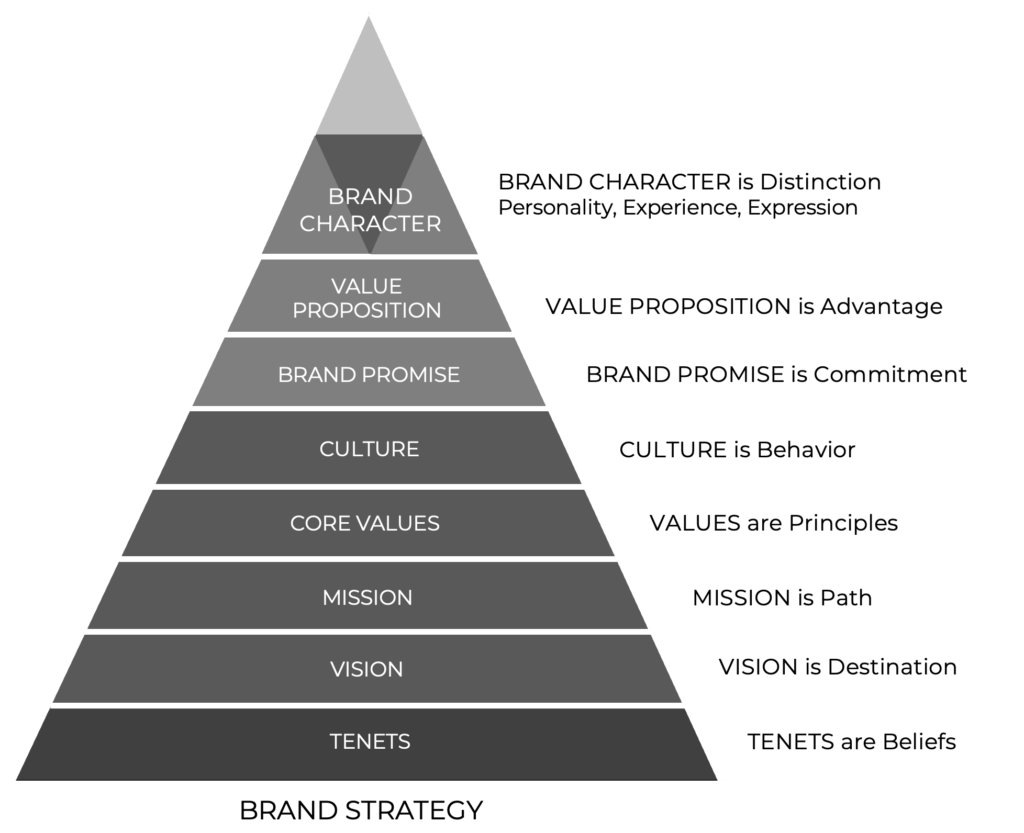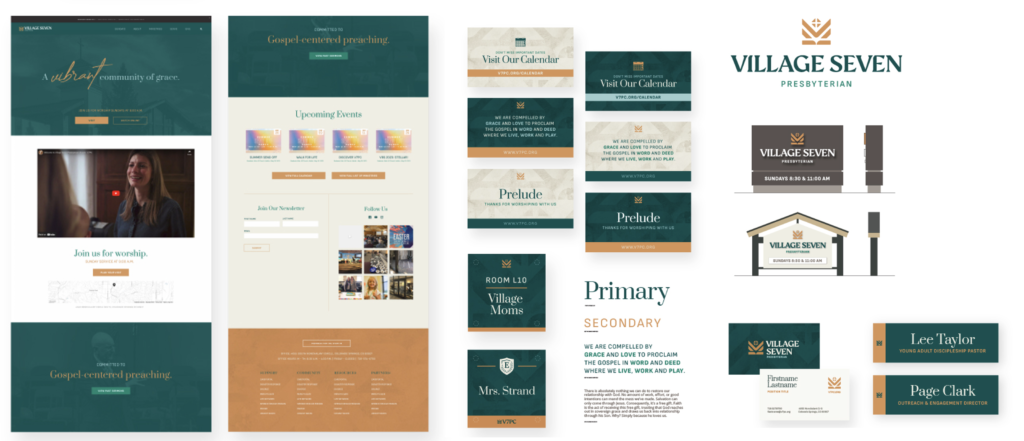The Rebranding of Village Seven Presbyterian Church.
America’s Changing Religious Landscape


According to recent PEW research, 65% of American adults describe themselves as Christians. That’s down 12 percentage points over the past decade. And more churches are closing than opening. A 2019 Lifeway Research study found that while 3000 new churches were started, 4500 churches closed. That’s a trend that has continued post-COVID. Many people just got out of the habit of attending church. But one of the big challenges has been how to attract and keep young adults engaged.
“The younger generation just doesn’t feel like they’re being accepted in a church environment or some of their choices aren’t being accepted by those at church”
Lifeway Research
Churches are finding that they have to adapt and find new ways to reach out and engage without compromising their core beliefs. Accepting change is essential to survival.
A Church Poised For Change


Village Seven Presbyterian Church began in 1972 in the Village Seven neighborhood of Colorado Springs. It is now one of the largest churches in the Rocky Mountain Presbytery (Colorado, Wyoming, and Montana) serving a congregation of around 1600 members. The church also supports 60+ missionaries in the US and around the world. It is a church known for its conservative and traditional roots.
But like many other churches, it has struggled to resonate with a younger generation. And it has wrestled with clear, focused, and meaningful messaging. Steadfast in its principles and mission the church leadership decided it was time to change, not its beliefs, but its brand.
“We want to be clear about what we are marketing. Have to offer something of value. Important to retain.”
Village Seven Brand Research Survey
Overcoming Resistance to Change
Churches by their nature are conservative — regardless of denomination. The thought of any kind of change is pretty much a non-starter. And thinking of the church as a brand that needs change is almost incomprehensible.
“A lot of people think that If it ain’t broke, don’t fix it. These people need convincing. “Rebranding” discussion was initially met with shock and aversion.”
Village Seven Brand Research Survey
A key challenge for this branding initiative was the anticipated resistance from church membership. Success depended on overcoming it. Three key initiatives made it work:
1. Education
Even among marketers and branding professionals, there is disagreement on what branding is. For the layperson, branding is simply seen as names, slogans, and logos. For church members, the term “rebrand” even raised fears that the project would challenge its foundational beliefs. The project was recast as a “brand refresh” initiative. This is why it was so important to educate stakeholders and members on the value of branding. And why it matters to the church. Branding would be an essential tool to reach out and engage in ways that would be meaningful and relevant.
2. Process
A step-by-step process was essential in guiding the decision-making through the project. This was done through 5 phases — Discovery, Brand Strategy, Design, Brand Training, and Brand Launch. Our responsibility was to frame the phase objectives, and summarize the background on issues and information that would affect the decision-making, provide clarity on the brand principles that would factor into a decision, and present solution options for consideration. The project team’s responsibility was to keep an open mind, actively engage in objective consideration, and provide clear feedback and direction.
3. Communication
The best way to break down resistance is to keep everyone informed, educated, and feeling like they are part of the process. We provided a summary of key activities, achievements, and the next milestones. Updates were shared internally with the staff and externally with church members through the Church’s website. This served to pave the way for a rebrand launch that would be less of a surprise and more of an expectation of evolutionary change that everyone could accept.
Give People a Voice
Everyone likes to be heard. And giving them a voice in shaping the Village Seven brand was essential. We conducted several online surveys among leadership, staff, and key stakeholders including influential members. It was key to giving members a voice. Over 800 responses were the result. Questions explored a variety of issues like culture, future goals, vision and mission, reputation, challenges, advocacy and benefit. To ensure that the respondents provided unbiased insights we utilized visual metaphoric stimuli. Brand benefits and advantages used car analogies.


Attributes associated with selecting the preferred choice of these vehicles identified: multi-purpose, reliability, flexibility, robust technology, and dependable helped shape a definition of brand advantage.
“Our Advantage is that we are ready to face the future with the flexibility and breadth of services that people can depend on and help people any life situation through robust and true teaching.“
Village Seven Brand Survey Results
Strategy is More Than a Mission Statement
The problem with strategy is that it can seem esoteric and impersonal. Vision and mission are important certainly. But vision and mission are only a couple pieces of a much more robust platform.


Brand Strategy has many dimensions that define what constitutes the essence of the brand. It is what guides internal behavior as well as outward expression. Village Seven had to be built on those tenets that were foundational to the Church. The goal of the rebrand work was to provide more clarity, focus, and direction that everyone could understand, embrace, and deliver on. Strategy needed to inspire and motivate staff. It had to translate into an engaging experience for members. And it had to guide the visual expression of the brand through a purposeful design.
“Success of our branding initiative would be to achieve a clear and common understanding of our mission and vision, and other aspects of our brand, that will create the image we would like to project to our community and city.“
Village Seven Brand Research Survey
Making the Brand Relatable
The role of strategy is to provide direction. But people need to understand and relate to it. There has to be a way to create an emotional connection. Brand character attributes (personality, voice, experience, and expression) was the way. Input from the surveys provided the important perspectives on what these should be:
Brand Personality. We used watches to explore the aspirational attributes associated with personality.


“A watch that reflects who we want to be should have a touch of style, not ahead of the curve or futuristic or overly techy but really connected to the common man, authentic, trusted, but versatile.”
Village Seven Brand Research Survey
Brand Voice. We used personalities to explore characteristics of how we connect with people through how we communicate.


“It is important that we speak in a warm, kind, relaxed, welcoming style and in a way that is knowledgable, believable, authentic, and humble.”
Village Seven Brand Research Survey
The Logo Has To Have a Purpose


A criticism of the current logo was that it was not an accurate reflection of what the Village Seven brand aspired to be. It lacked the kind of substance that reflects what the Church stands for.
The logo had lost distinction within the category. Nothing special or unique. But this was the challenge of a new design that would reinforce the Village Seven brand, re-energize the staff, and appeal to a broader and younger audience.
“Our logo needs to be something that is simple, classic, respect for roots/history; forward-thinking, artistically pleasing, relevant, and engaging to indicate movement towards future.“
Village Seven Brand Research Survey
A Meaning With Distinction. The opportunity with a new logo design was to create something that would be engaging, distinctive, and memorable. And it was essential that the new brand identity serve a purpose. It had to have meaning and relevance to what the Church was all about.


Building the System. The true value of a brand identity system is how well it can adapt to a range of applications and formats to tell the Village Seven story.




Managing the Brand. The real challenge with any brand is managing it over the long-term after the strategic foundation and branding system have been defined. But there will always be situations that require interpretation of branding principles. Therefore it was essential to provide the right kind of tools that would help in overseeing brand consistency.
The Brand Guidelines summarise the visual expression principles. While the Brand Book, on the other hand, captures the principles of brand strategy. The Brand Book is especially helpful as a reference for internal staff whose behavior is guided by core values and mission. This became a valuable tool for Village Seven in educating its staff on how to live the brand in a way that would support its brand aspirations.


Bringing the Brand to Life
Village Seven leadership and staff ultimately have the responsibility to bring the brand to life. The goal of this rebrand initiative was to provide a rebrand solution that would inspire and motivate everyone to embrace, advance, and protect something unique to Village Seven Presbyterian Church.
“Our brand needs to not only tell folks who we are but is visible evidence of what we aspire to be.”
Village Seven Brand Research Survey



